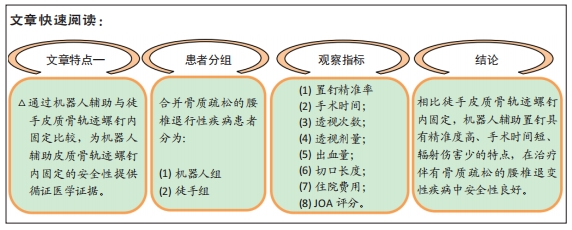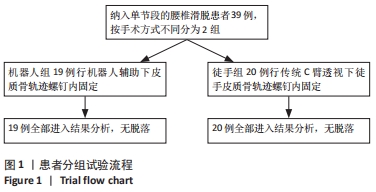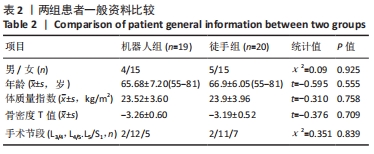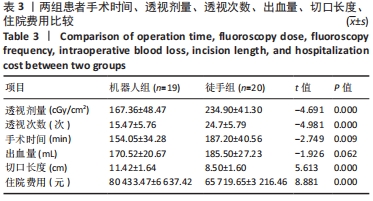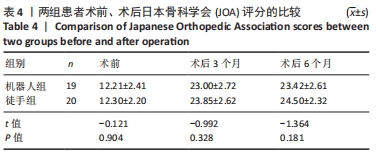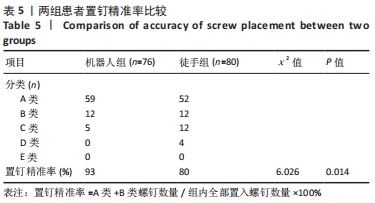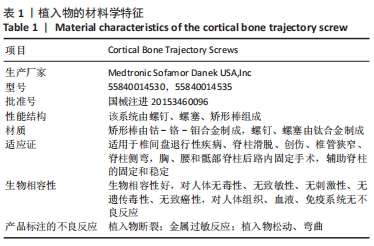[1] 刘博,谷元,王鹏,等.椎体后凸成形术治疗580例老年性骨质疏松性椎体压缩性骨折疗效的影响因素分析[J].中国骨质疏松杂志, 2019,25(10):1469-1473.
[2] REXITI P, AIERKEN G, WANG S, et al. Anatomical research on strength of screw track fixation in novel cortical bone trajectory for osteoporosis lumbar spine. Am J Transl Res. 2019;11(11):6850-6859.
[3] SANTONI BG, HYNES RA, MCGILVRAY KC, et al. Cortical bone trajectory for lumbar pedicle screws. Spine J. 2009;9(5):366-373.
[4] DELGADO-FERNANDEZ J, GARCIA-PALLERO MA, BLASCO G, et al. Review of cortical bone trajectory: evidence of a new technique. Asian Spine J. 2017;11(5):817-831.
[5] LI HM, ZHANG RJ, GAO H, et al. Biomechanical fixation properties of the cortical bone trajectory in the osteoporotic lumbar spine. World Neurosurg. 2018;119:e717-e727.
[6] HUANG M, TETREAULT TA, VAISHNAV A, et al. The current state of navigation in robotic spine surgery. Ann Transl Med. 2021;9(1):86.
[7] 林书,胡豇,万仑,等.骨科机器人辅助经皮椎体后凸成形治疗多节段脊柱转移瘤[J].中国组织工程研究,2020,24(33):5249-5254.
[8] 林书,胡豇,万仑,等.机器人与透视辅助经皮椎弓根螺钉置入的比较[J].中国矫形外科杂志,2020,28(20):1830-1834.
[9] GERTZBEIN SD, ROBBINS SE. Accuracy of pedicular screw placement in vivo. Spine (Phila Pa 1976). 1990;15(1):11-14.
[10] WEISER L, HUBER G, SELLENSCHLOH K, et al.Insufficient stability of pedicle screws in osteoporotic vertebrae: biomechanical correlation of bone mineral density and pedicle screw fixation strength. Eur Spine J. 2017;26(11):2891-2897.
[11] WU ZX, GONG FT, LIU L, et al. A comparative study on screw loosening in osteoporotic lumbar spine fusion between expandable and conventional pedicle screws. Arch Orthop Trauma Surg. 2012;132(4): 471-476.
[12] GAO H, ZHANG R, JIA C, et al. Novel Placement of Cortical Bone Trajectory Screws in the Lumbar Spine: A Radiographic and Cadaveric Study. Clin Spine Surg. 2018;31(6):E329-E336.
[13] SKINNER R, MAYBEE J, TRANSFELDT E, et al. Experimental pullout testing and comparison of variables in transpedicular screw fixation. A biomechanical study. Spine (Phila Pa 1976). 1990;15(3):195-201.
[14] ZHOU X, MENG X, ZHU H, et al.Early versus late percutaneous kyphoplasty for treating osteoporotic vertebral compression fracture:A retrospective study. Clin Neurol Neurosurg. 2019;180:101-105.
[15] 任航宁,居来提·买提肉孜,帕尔哈提·热西提,等.皮质骨轨迹椎弓根系统拔出力下腰椎的有限元分析[J].中国组织工程研究, 2021,25(36):5771-5776.
[16] MATSUKAWA K, YATO Y, KATO T, et al. In vivo analysis of insertional torque during pedicle screwing using cortical bone trajectory technique. Spine ( Phila Pa 1976). 2014;39(4):E240-245.
[17] MATSUKAWA K, YATO Y, IMABAYASHI H, et al.Biomechanical evaluation of lumbar pedicle screws in spondylolytic vertebrae: comparison of fixation strength between the traditional trajectory and a cortical bone trajectory. J Neurosurg Spine: 2016;24(6):910-915.
[18] 付荣华,耿晓鹏,付国勇,等.椎弓根皮质骨通道与常规通道螺钉治疗骨质疏松性腰椎疾病[J].中国矫形外科杂志,2020,28(5):405-409.
[19] LE X, TIAN W, SHI Z, et al. Robot-assisted versus fluoroscopy-assisted cortical bone trajectory screw instrumentation in lumbar spinal surgery: a matched-cohort comparison. World Neurosurg. 2018;120: e745-e751.
[20] MATSUKAWA K, KAITO T, ABE Y. Accuracy of cortical bone trajectory screw placement using patient-specific template guide system.Neurosurg Rev. 2020;43(4):1135-1142.
[21] 林书,胡豇,万仑,等.“天玑”骨科机器人辅助下经皮椎弓根螺钉植钉安全性评价[J].中国修复重建外科杂志,2021,35(7):813-817.
[22] MECHLENBURG I, DAUGAARD H, SØBALLE K. Radiation exposure to the orthopaedic surgeon during periacetabular osteotomy. Int Orthop. 2009;33:1747-1751.
[23] CHIANG HW, LIU YL, CHEN TR, et al. Scattered radiation doses absorbed by technicians at different distances from X-ray exposure: experiments on prosthesis. Biomed Mater Eng. 2015;26(suppl 1):S1641-S1650.
[24] KERIC N, EUM DJ, AFGHANYAR F, et al. Evaluation of surgical strategy of conventional vs percutaneous robot-assisted spinal transpedicular instrumentation in spondylodiscitis. J Robot Surg. 2017;11:17-25.
[25] ZHANG Q, XU YF, TIAN W, et al. Comparison of Superior-Level Facet Joint Violations Between Robot-Assisted Percutaneous Pedicle Screw Placement and Conventional Open Fluoroscopic-Guided Pedicle Screw Placement. Orthop Surg. 2019;11(5):850-856.
[26] FENG S, TIAN W, SUN Y, et al. Effect of Robot-Assisted Surgery on Lumbar Pedicle Screw Internal Fixation in Patients with Osteoporosis.World Neurosurg. 2019;125:e1057-e1062.
[27] HAN X, TIAN W, LIU Y, et al. Safety and accuracy of robot-assisted versus fluoroscopy-assisted pedicle screw insertion in thoracolumbar spinal surgery:a prospective randomized controlled trial. J Neurosurg Spine. 2019;8:1- 8.
[28] YANG JS, HE B, TIAN F, et al. Accuracy of Robot-Assisted Percutaneous Pedicle Screw Placement for Treatment of Lumbar Spondylolisthesis: A Comparative Cohort Study. Med Sci Monit. 2019;25:2479-2487.
|
